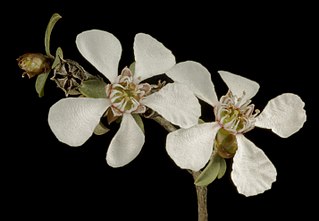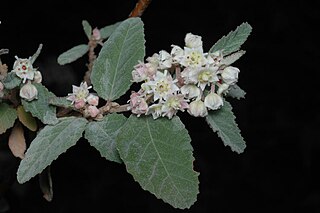
Leptospermum erubescens, commonly known as the roadside tea tree, is a species of shrub that is endemic to southwest of Western Australia. It has thin, fibrous bark, egg-shaped leaves, small white flowers and woody fruit.

Leptospermum inelegans is a species of straggly shrub that is endemic to Western Australia. It has only partly hairy young stems, egg-shaped to narrow elliptical leaves on a short petiole, relatively small white or pink flowers and fruit that fall from the plant when mature.

Pityrodia ternifolia is a species of flowering plant in the mint family, Lamiaceae and is endemic to north-western Australia. It is an erect shrub with densely hairy stems, sticky and prickly, egg-shaped leaves, and mauve or pinkish-red, tube-shaped flowers.

Androcalva luteiflora is a species of flowering plant in the family Malvaceae and is endemic to western Australia. It is an erect, sucker-forming shrub with egg-shaped leaves, the edges irregularly toothed, and clusters of 3 to 18 or more yellow flowers.
Goodenia centralis is a species of flowering plant in the family Goodeniaceae and is endemic to central Australia. It is a prostrate, annual herb with coarsely toothed, spatula-shaped to egg-shaped leaves with the narrower end towards the base, and racemes of yellow flowers with purple veins.

Commersonia corniculata is a species of flowering plant in the family Malvaceae and is endemic to the southwest of Western Australia. It is an erect to prostrate shrub with 3-lobed, egg-shaped leaves, and white to cream-coloured flowers.

Teucrium integrifolium, commonly known as teucry weed or green germander, is a species of flowering plant in the family Lamiaceae and is endemic to northern Australia. It is a perennial herb with broadly elliptic to broadly egg-shaped leaves and white or cream-coloured flowers.
Goodenia psammophila is a species of flowering plant in the family Goodeniaceae and endemic to the Kimberley region of Western Australia. It is a prostrate or erect annual herb with narrow lance-shaped to egg-shaped leaves with the narrower end towards the base, and racemes of yellow flowers with brownish or whitish lobes.
Goodenia pumilio is a species of flowering plant in the family Goodeniaceae and is native to northern Australia and New Guinea. It is a prostrate, stolon-forming herb with egg-shaped to lance-shaped leaves in rosettes, and racemes of small, dark reddish-purple flowers.

Goodenia watsonii is a species of flowering plant in the family Goodeniaceae and is endemic to the south-west of Western Australia. It is a perennial herb with egg-shaped to elliptic leaves mostly at the base of the plant, and thyrses of white, cream-coloured or bluish flowers.

Stenanthemum intricatum is a species of flowering plant in the family Rhamnaceae and is endemic to the southwest of Western Australia. It is an erect to spreading, often wiry shrub with sparsely hairy young stems, egg-shaped to fan-shaped leaves and greyish, densely softly-hairy heads of white or cream-coloured flowers.

Stenanthemum nanum is a species of flowering plant in the family Rhamnaceae and is endemic to the south-west of Western Australia. It is a prostrate shrub with hairy young stems, broadly egg-shaped leaves with the narrower end towards the base, and densely silvery-hairy heads of white or cream-coloured flowers.
Androcalva cuneata is a species of flowering plant in the family Malvaceae and is endemic to the south-west of Western Australia. It is a low, spreading, densely hairy shrub that sometimes forms suckers and has wedge-shaped leaves and clusters of 5 to 15 pink flowers.

Androcalva loxophylla is a species of flowering plant in the family Malvaceae and is endemic to northern Australia. It is a shrub with spreading or low-lying branches, oblong to broadly elliptic leaves and clusters of 4 to 20 yellow flowers.

Androcalva procumbens is a species of flowering plant in the family Malvaceae and is endemic to central New South Wales. It is a prostrate shrub covered with star-shaped hairs, and with slender, trailing stems, egg-shaped to narrowly egg-shaped or lance-shaped leaves with scalloped or lobed edges, and clusters of 4 to 10 white, pink and yellow flowers.
Commersonia parviflora, commonly known as small flowered rulingia, is a species of flowering plant in the family Malvaceae and is endemic to the south of Western Australia. It is a low, prostrate or dense shrub with wrinkled, egg-shaped leaves with rounded teeth on the edges, and clusters of small, white flowers.

Commersonia prostrata, commonly known as dwarf kerrawang, is a species of flowering plant in the family Malvaceae and endemic to eastern continental Australia. It is a prostrate shrub with trailing branches, egg-shaped leaves, the lower surface densely covered with star-like hairs, white, petal-like sepals, and smaller, pinkish petals.
Commersonia rotundifolia, commonly known as round-leaved rulingia, is a species of flowering plant in the family Malvaceae and endemic to the south-west of Western Australia. It is an upright, openly-branched shrub with elliptic to round leaves with wavy edges, and white flowers in clusters of 3 to 10.

Commersonia erythrogyna, commonly known as Trigwell's rulingia, is a species of flowering plant in the family Malvaceae and is endemic to a restricted part of the south-west of Western Australia. It is an open, straggly shrub with oblong to egg-shaped leaves and creamy-white flowers.
Commersonia gilva, commonly known as golden commersonia, is a species of flowering plant in the family Malvaceae and is endemic to the south-west of Western Australia. It is an erect shrub with elliptic to oblong or egg-shaped leaves and yellow flowers.













